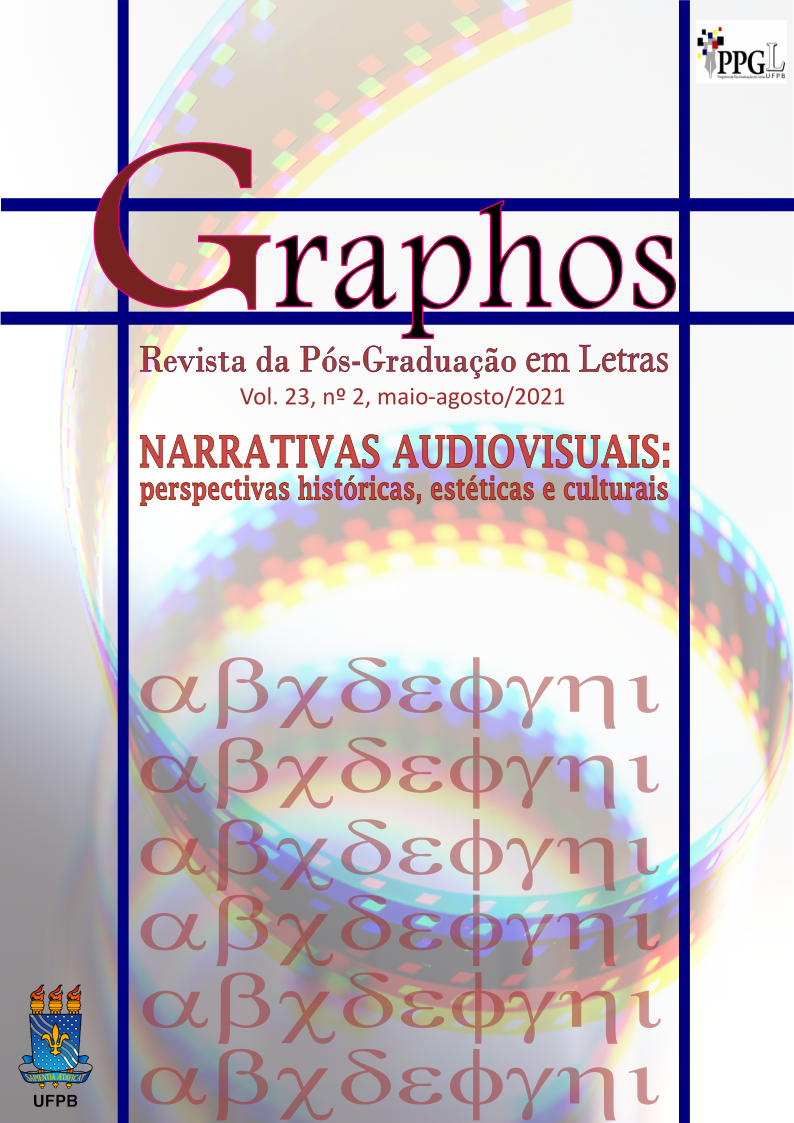Document-matter and sensory effect in Renata Pinheiro’s contemporary art and cinema
DOI:
https://doi.org/10.22478/ufpb.1516-1536.2021v23n2.59136Keywords:
Contemporary Art, Memory, Document, Cinema, Production designAbstract
This paper analyses the relationship between cinema and contemporary arts focusing on Renata Pinheiro’s work as a visual artist, a production designer and a director. The focus is on how aesthetic and discursive procedures arising from the use of spaces and objects marked by time creates an affective and sensory dimension that evokes other temporalities and alterities, adding material aspects of memory to the process of shaping the work. For a better approximation to the theme and formulation of the operative concepts, other contemporary artistic manifestations in works by visual artists such as Rosângela Rennó, Richard Serra and Simryn Gill and in a theatrical production by the group Teatro da Vertigem were also accounted. Renata Pinheiro’s works use resonance of matter as an aesthetic potential, which produces a displacement of meanings previously generated in the dynamics of object’s insertion and use in other social relations, prior to its appropriation by the work. This evocative capacity is what is here called document matter. Added to this are the immersive properties generated by the reconfiguration of the experience with space, an attribute of the installation work, which allows the observer to build his experience in the sensory inter-relation between body, work, and context.
Downloads
References
ALVARENGA, André. Lugar e memória: cenários. Revista GEOgraphia, v. 19, n. 41, 2017. Disponível em: <https://periodicos.uff.br/geographia/article/ view/13822>. Acesso em: 10 jul. 2021.
ANJOS, Moacir dos. Desconcertos da Forma. In: RIBENBOIM, Ricardo (ap.). Mapeamento Nacional da Produção Emergente: Rumos Itaú Cultural. São Paulo: Imprensa Oficial Unesp, 2000.
AROMA Filmes. Superbarroco, 2011. Disponível em: <https://vimeo.com/18791604>. Acesso em: 30 abr. 2021.
ASSMANN, Aleida. Espaços da recordação: formas e transformações da memória cultural. Campinas: Editora da Unicamp, 2011.
BACHELARD, G. A poética do espaço. São Paulo: Martins Fontes, 2008.
BARTHES, Roland. A câmara clara: nota sobre a fotografia. Rio de Janeiro: Nova Fronteira, 1984.
BAUDRILLARD, Jean. O sistema dos objetos. Perspectiva: São Paulo, 2009.
BEST, Susan. What is Affect? Considering the Affective Dimension of Contemporary Installation Art. Australian and New Zealand Journal of Art, n. 3, 2015.
BERGSON, H. Matéria e memória. São Paulo: Martins Fontes, 2010.
CASEY, E. The fate of place. Berkeley: University of Califórnia Press, 1997.
CRIMP, Douglas. Sobre as ruínas do museu. São Paulo: Martins Fontes, 2005.
CROCKER, S. Sounds complicated: what sixties audio experiments can teach us about the new media environments. In: J. MARCHESSAULT; S. LORD (ed.). Fluid screens, expanded cinema. Toronto: University of Toronto Press, 2007. p. 52-73.
DOMINGUES, Diana. As instalações multimídia como espaços de dados em sinestesia. In: FECHINE, Yvana; OLIVEIRA, Ana Claudia de (Org.). Imagens Técnicas. São Paulo: Hacker Editores, 1998.
ENCICLOPÉDIA Itaú Cultural de Arte e Cultura Brasileiras. São Paulo: Itaú Cultural, 2021. Disponível em: <http://enciclopedia.itaucultural.org.br/pessoa26985/renata-pinheiro>. Acesso em: 30 abr. 2021.
FESTIVAL do Rio. Revista Continente, 2021. Disponível em: <https://revistacontinente.com.br/secoes/curtas/ festival-do-rio>. Acesso em: 10 set. 2021.
GARRAMUÑO, Florencia. Políticas da memória na arte contemporânea: “Imemorial”, de Rosângela Rennó. Trad. Martina Altalef. Revista Transas. Letras y artes de América Latina, 21 dez. 2017. Disponível em: <http://www.revistatransas.com/2017/12/21/politicas-da-memoria-na-arte-contemporanea/>. Acesso em: 05 abr. 2021.
HAMBURGER, Vera. O desenho do espaço cênico: da experiência vivencial à forma. 2014. 323 f. Dissertação (Mestrado em Artes Cênicas) – Programa de Pós- Graduação em Artes, Universidade de São Paulo, São Paulo.
LE GOFF, Jacques. História & Memória. Campinas: Editora da Unicamp, 2013.
LIMA, Dellani; IKEDA, Marcelo. Cinema de garagem: Um inventário afetivo sobre o jovem cinema brasileiro do século XXI. Belo Horizonte: SuburbanaCo, 2011.
MALPAS, J. Place and experience. Cambridge: Cambridge University Press, 1999.
MARKS, Laura U. The skin of the film: Intercultural Cinema, Embodiment, and the Senses. Durham, London: Duke University Press, 2000.
MENEZES, Ulpiano T. Bezerra de. Memória e Cultura Material: Documentos Pessoais no Espaço Público. Revista Estudos Históricos, v. 11, n. 21, p. 89-104, 1998. Disponível em: <http://bibliotecadigital.fgv.br/ojs/index.php/reh/article/view/2067>. Acesso em: 05 abr. 2021.
MEREWETHER, Charles. “Archives of the Fallen // 1997”. In The Archive: Documents of Contemporary Art. London e Cambridge, Massachusetts: Whitechapel e MIT Press, 2006. p. 160-162. Disponível em: <http://www.rosangelarenno.com.br/obras/about/19>. Acesso em: 05 abr. 2021.
MERLEAU-PONTY, M. O visível e o invisível. São Paulo: Perspectiva, 2009.
MONTEIRO, Eliana. Metrópolis: Entrevista com Teatro da Vertigem. Youtube, 03 jul. 2015. Disponível em: <https://www.youtube.com/watch?v=TuwrHOgL7rs>. Acesso em: 05 abr. 2021.
NORA, Pierre. Entre Memória e História. A problemática dos lugares. Trad. Yara Aun Khoury. Proj. História, São Paulo, v. 10, dez. 1993.
PAÏNI, Dominique. Por que se expõe o cinema. Disponível em: <https://www.e-publicacoes.uerj.br/index.php/concinnitas/article/viewFile/55518/35594>. Acesso em: 10 fev. 2021.
PARENTE, André. O golpe do corte de Sólon Ribeiro. In: MACIEL, Kátia (Org.). Transcinemas. Rio de Janeiro: Contra Capa, 2009. p. 255-262.
PETRIN, Antônio. Metrópolis: Entrevista com Teatro da Vertigem. Youtube, 03 jul. 2015. Disponível em: <https://www.youtube.com/watch?v=TuwrHOgL7rs>. Acesso em: 05 abr. 2021
PINHEIRO, Jane. Arte Contemporânea no Recife dos anos 90: Grupo Camelo, Grupo Carga e Descarga e Betânia Luna. 1999. 168 f. Dissertação (Mestrado em Antropologia) – Universidade Federal de Pernambuco, Recife.
PINHEIRO, Renata. Arquivo pessoal. Entrevista realizada por Skype em 11 de junho de 2019.
PORTA Curtas. Praça Walt Disney, 2011. Disponível em: <https://portacurtas.org.br/filme/default.aspx?name=praca_walt_disney>. Acesso em: 30 abr. 2021.
REPÚBLICA Pureza. Amarelo Manga – Trailer, 2020. Disponível em: <https://vimeo.com/430603958>. Acesso em: 12 set. 2021.
ROLNIK. Suely. Subjetividade em obra: Lygia Clark, artista contemporânea. 2007. Conferência proferida no Museu d’Art Contemporani de Barcelona, por ocasião das exposições Zuch Tecura e The Prinzhorn Collection: Traces upon the Wonderblock (Barcelona, 2001). Disponível em: <http://www.pucsp.br/nucleodesubjetividade/Textos/SUELY/Subjemobra.pdf>. Acesso em: 01 jul. 2021.
ROLNIK. Suely. Molda-se uma arte contemporânea: o vazio-pleno de Lygia Clark. In: THE MUSEUM OF CONTEMPORARY ART. The Experimental Exercise of Freedom: Lygia Clark, Gego, Mathias Goeritz, Hélio Oiticica and Mira Schendel. Los Angeles: The Museum of Contemporary Art, 1999. Disponível em: <https://www.pucsp.br/nucleodesubjetividade/Textos/SUELY/Molda.pdf>. Acesso em: 09 jul. 2021.
RUTHERFORD, Anne. Precarious boundaries: affect, mise-en-scène, and the senses. In: SMITH, Richard Cándida (org.). Art and the Performance of Memory Sounds and Gestures of Recollection. London; New York, Routledge, 2002.
RUTHERFORD, Anne. The poetics of a potato: Documentary that gets under the skin. Metro Magazine, n. 137, 2003.
SOBCHACK, Vivian Carol. Carnal Thoughts – embodiment and moving image culture. Berkeley; Los Angeles, University of California Press, 2004.
TARKOVSKY, Andrei. Esculpir o tempo. São Paulo: Martins, 1998.
Downloads
Published
Issue
Section
License
Copyright (c) 2021 Tainá Xavier, Iomana Rocha

This work is licensed under a Creative Commons Attribution 4.0 International License.







